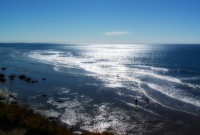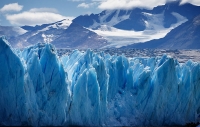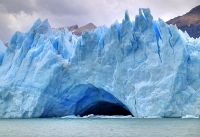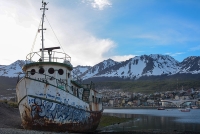
One look at the beautiful beaches was all the residents at Las Grutas needed to start building what would become one of Argentina's most popular resorts. The landscape is dramatic, with cliffs and plateaus shielding hidden beaches and caves, giving way to dramatic sea views.Las Grutas has a few main beaches numbered from zero to seven, with zero being the closest to downtown. The town's position on the Atlantic coast gives it some of the warmest waters in Argentina, and the rugged coastline makes the area ideal for paragliding, hiking and other activities. There are scuba diving facilities, and several spas that offer Thalassotherapy treatments using local resources.Las Grutas itself is a small town with a few hotels and restaurants, but it makes a great base from which to explore other interesting beaches and towns in the area, including San Antonia Oeste, Puerto Madryn, Sierra Grande, and Punta Tombo.

Adventurous travellers are drawn to the savage beauty and rich wildlife of Patagonia. This region of contrasts and extremes, stretching across Argentina and Chile, runs from the Colorado river, south of Buenos Aires, across to the southern tip of South America. Many people visit the famous wildlife reserve of Peninsula Valdésgo between July and April, where southern right whales, elephant seals and other rare marine mammals come to breed in their thousands. However, those going further south should visit only in the summer months if they wish to avoid temperatures that plummet to -13°F (-25°C).In villages along the valley of the Río Chubut, visitors can explore the cultural legacy of the Welsh pioneers, and nearby at Punta Tombo lies the continent's largest penguin colony. Keen fly-fishermen come from around the world to test their skills in the region's rivers, the best known of which is the Río Gallegos. On the western fringe, along the Andes, you will find the most impressive of Patagonia's great lakes and national parks. The Parque Nacional Perito Moreno, home to the aquamarine gem of Lago Belgrano, has excellent trekking possibilities, as does the Parque Nacional Los Glaciares. Here visitors will find one of the world's natural wonders, the vast Perito Moreno Glacier, a great river of ice that breaks off into Lake Argentino.

Situated in Los Glaciares National Park, a UNESCO World Heritage site, the breathtaking Perito Moreno Glacier is nearly 19 miles (30km) in length and spreads over an area of 97 square miles (250 sq km). The spectacular, blue-white ice formation is one of the only glaciers in the world that is growing, at a rate of seven feet (2m) per day. Visitors can marvel at the site of the glacier 'calving': enormous chunks of ice breaking off into the water with a deafening crash, creating icebergs and causing large waves.The glacier is also world renowned for its unique rupturing process; at certain periods the glacier's front reaches the coastal border of the lake, blocking off the flow of water from the Andes and causing its waters to rise by about 66 feet (20m). When the pressure is too much, the dam of ice cracks and shatters, sending icebergs downstream. Ruptures like this occur on average every four to five years, although sometimes as often as every other year; the most recent rupture occurred in March 2016.The closest town to this natural wonder is El Calafate in Argentina's Santa Cruz Province, which is about two hours' drive away. There are regular buses from El Calafate to the glacier. Tour companies operating from El Calafate offer trekking trips that take visitors out onto the glacier's ice, for anywhere from one to five hours.
Address : Los Glaciares National Park
Website : www.losglaciares.com
Telephone : Los Glaciares National Park Administrative Centre: (0)2902 491 005

This island territory at the tip of South America is shared by Chile and Argentina and is a place of staggering scenery. Though further south, the region does not reach the extreme temperatures of neighbouring Patagonia, but it is still not for the faint-hearted. The principal tourist destination is Ushuaia, which acts as a base for those visiting the dramatic Canal Beagle, or trekking in the Parque Nacional Tierra del Fuego and the mountain ranges of southern Tierra del Fuego, with its magnificent scenery of lakes, snow-capped mountains and beechwood forests.Ushuaia is also the place to go if you want to visit Antarctica, since many ships depart from there on journeys stopping at several islands and taking in penguin colonies, seal and sea lion colonies, massive sea bird colonies, and more. The Les Eclaireurs Lighthouse is another attraction found in Ushuaia, and the area plays host to a few small ski resorts, featuring both downhill and cross-country skiing. There is less reason to visit the north of the island unless you are a keen fly-fishermen heading to the Río Grande, the world's best brown-trout river.
Website : http://www.tierradelfuego.org.ar/

Travel Guide powered by Word Travels, copyright © 2023 Globe Media Ltd. By its very nature information in this travel guide is subject to change at short notice and travellers are urged to verify information on which they're relying with the relevant authorities. Neither Globe Media Ltd nor Travel Vogue can accept any responsibility for any loss or inconvenience to any person as a result of information contained above.